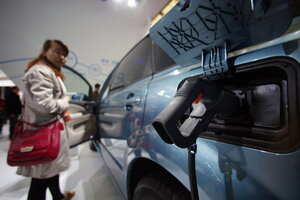China pumps up production of electric cars, plug-in hybrids vehicles in June
China's electric car market continues to grow: the country's carmakers built 25,000 electric cars in June, making up nearly a third of all electric vehicles built this year.

A woman looks at a BYD E6 electric car during the 15th Shanghai International Automobile Industry Exhibition in Shanghai April 21, 2013. China's carmakers built 25,000 electric cars in June, making up nearly a third of all electric vehicles built this year.
Carlos Barria/Reuters/File
The Chinese vehicle market is now the world's largest, and has been for a few years now.
And the country's government-industrial complex has ambitious plans to dominate global production of plug-in electric vehicles, both for reasons of competitiveness and as one effort to start to reduce its endemic and hazardous air pollution.
In the last few months, the country's carmakers have apparently started to build plug-in electric cars--known in China as "New Energy Vehicles"--at rates that exceed those of Japan and the U.S.
According to news site Gasgoo, citing statistics from the Ministry of Industry published in the Beijing Daily, the country's automakers collectively built 25,000 new-energy vehicles in June alone.
The total was made up of 10,500 battery-electric and 6,663 plug-in hybrid passenger cars, along with 6,218 battery-electric and 1,645 plug-in hybrid commercial vehicles.
That figure is a huge jump from the pace at the beginning of the year, since it's roughly one-third of the total 78,500 built during the first six months of the year.
It's important to note, however, that those totals are not directly comparable to total sales of battery-electric and plug-in hybrid vehicles published by Green Car Reports and other outlets.
The North American sales data, both for the U.S. and Canada, include only highway-capable vehicles that meet all Federal motor vehicle safety standards.
The Chinese data, on the other hand, includes some proportion of what would be deemed low-speed or neighborhood electric vehicles by the National Highway Traffic Safety Administration.
Those vehicles generally have top speeds of 35 mph or so, and often have little more equipment than brakes, lights, wipers, seat belts, and perhaps an audio system.
The Chinese auto industry is now producing plug-in cars in fast-increasing volumes, albeit perhaps not altogether willingly.
But while there's little doubt that the trend will continue, it's important to understand that when discussing China's raw production and sales numbers to those from the U.S., Japan, and various European countries, you're not yet comparing apples to apples.
Any possible Apple electric car, of course, is a different discussion altogether.

